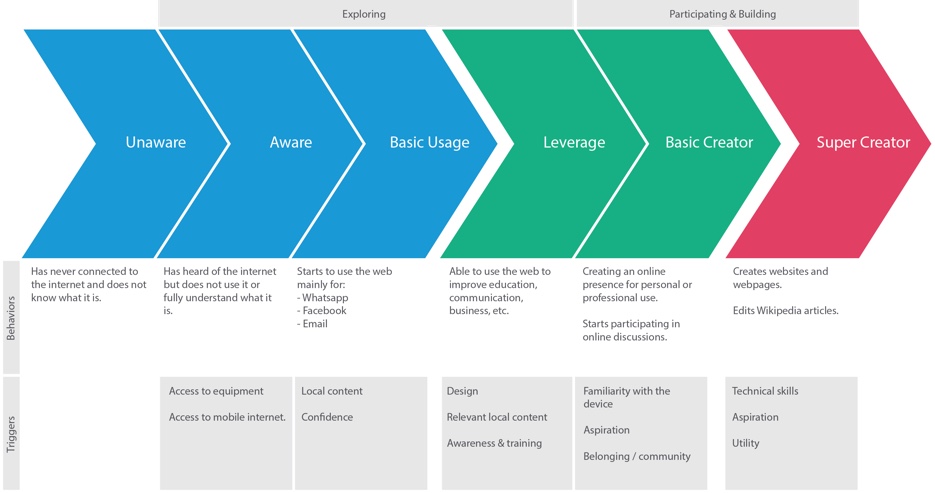Investing in web literacy — tools for thinking
Mozilla Foundation is currently in strategic reflection — how will we invest in web literacy over the next few years?
In the last five years, we’ve grown the Mozilla Foundation to 80 people and a $20m operating budget. We have lots of experience in learning and leadership development, and an evolving theory of web literacy. Now is the time to evaluate the strategy underlying our programs, and make sure we are on track for long-term impact and sustainability. Mark Surman has been continuously documenting this process.
Mozilla’s mission is to protect the internet as a shared public resource. Within that mission, the Mozilla Foundation focuses on web literacy. We can see a future in which all jobs will become, in some sense, digital jobs. One’s livelihood will be impacted by how well she understands and interacts with the digital world. At the same time, people will need to be web literate to participate in civic and political life. So we think that some universal baseline of web literacy is important for both social and economic reasons.
If we were a large NGO or charitable foundation whose concern was global health, you can imagine the range of possible interventions in that domain. We could invest in broad public health education. Technical innovations in patient care. Build hospitals. Invest in R&D for new medicines. Of course, to have a meaningful impact, we’d need a theory of where time and money are best spent, and a consistent strategy for implementation.
Here’s one tool we’re using to think through the opportunity space (i.e., where to invest in web literacy). It builds on the work of Richard Heeks, a lecturer and researcher in international development. As people gain more exposure to technology, they climb the “ladder of user capabilities.” (This is imagined as user roles in an economic development context, but we can generalize). The distribution of user roles will vary in each society and economic setting.
To begin, we can crudely map this “ladder of user” roles along a curve. This is basically a global distribution of web users. It’s very notional but helps us have conversations across a huge conceptual space.

Web literacy, globally. This curve will shift as more of humanity gets connected over the next decade
Since the orange box is where a lot of Mozilla’s programs are currently concentrated, let’s zoom in a bit:

The right side of the skills curve
We can invest in a variety of learning programs, but we need to minimize the number of underlying strategies.
Near the top left is where you would plot programs which are meant to address the broadest number of people (such as large-scale campaigns and consumer education). Near the bottom right are things which address a smaller number of people, but have much more meaningful and direct effects in people’s lives (such as fellowships).

Where do we focus on the skills curve?
Plotting each of Mozilla’s current learning programs is an interesting exercise. We know that our programs are all over the map, serving different people, and operating at different scales. But plotting those programs along the curve is still a helpful visualization of what these programs aspire to.

Mozilla’s current learning programs, mapped onto our skills curve
In this mapping exercise, we’ve focused on the digital skills development of our direct program beneficiaries. (I.e. in the case of Hive, we are focused on the educators who we are directly serving, not the universe of youth who are indirectly served by their teaching).
We can go even further, and map the personas of Mozilla’s current learning programs, and where we aspire to take them in their digital skills development:

Where are our programs trying to take people?
As an example—in the Webmaker product team, we have developed a theory of personal transformation. One of the product’s goals is to help people move from being passive users to active creators, per below.

The product’s strategy (in terms of resourcing, features, marketing, community engagement and fundraising) grows from here.
While all of the Mozilla Learning programs have a common ethos, they have subtle but important differences which makes community and funder engagement a complicated task. While we have a fairly consistent vision, it’s hard for Mozilla to pursue so many different strategies simultaneously. So, how can we harmonize? What are the underlying strateg(ies) that we can identify and optimize?

What’s the right way to optimize our learning portfolio? Can we do all of these things at current resource levels? Some initial thinking
This skills curve is one of the primary mental models that we are using to understand the conceptual space. At the Mozilla staff summit in Whistler, we’ll start working on harmonization of program models. This planning work will ramp up over the summer, with work on benchmarking, market size, market fit, growth and long-term sustainability. If you’re interested in getting involved, head over to https://wiki.mozilla.org/Learning/Strategy.
About this entry
You’re currently reading “Investing in web literacy — tools for thinking,” an entry on Ben's blog.
- Published:
- 6.3.15 / 10pm
- Category:
- Economic development, Equity, Innovation, Learning, Mozilla, Strategy, Web Makers
- Tags:


Comments are closed
Comments are currently closed on this entry.